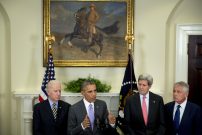Ending the (Actually) Longest War
President Obama said in his Veterans Day remarks at Arlington National Cemetery Monday that when responsibility for security in Afghanistan is transferred next year, America’s “longest war” will come to a close. But America’s longest war, the ongoing war on terror, was authorized by a Congressional resolution—the Authorization for Use of Military Force—whose alteration or repeal he endorsed six months ago but that will almost certainly endure. The promised “engagement” with Congress about its repeal has not occurred because a variety of actions and policies in the war on terrorism, from drone attacks to detention, depend on the AUMF remaining in force. The longest war persists for reasons of the longest motive: power.
In his May speech at the National Defense University—now six months ago—Obama explained:
The AUMF is now nearly 12 years old. The Afghan war is coming to an end. Core al Qaeda is a shell of its former self. Groups like AQAP must be dealt with, but in the years to come, not every collection of thugs that labels themselves al Qaeda will pose a credible threat to the United States. Unless we discipline our thinking, our definitions, our actions, we may be drawn into more wars we don’t need to fight, or continue to grant Presidents unbound powers more suited for traditional armed conflicts between nation states. So I look forward to engaging Congress and the American people in efforts to refine, and ultimately repeal, the AUMF’s mandate.
If the Afghan war is coming to an end and core al Qaeda is a shadow, the justification for the AUMF is at an end too. It did not license presidents to fight terrorism simply. Stunningly, in fact, its preamble ceded the claim that they possessed that authority inherently. Instead, it specifically licensed the prosecution of conflict only against those responsible for the 9/11 attacks. Indeed, Congress specifically rejected the Bush Administration’s breathtaking request for sweeping authority “to deter and pre-empt any future acts of terrorism or aggression against the United States.”
Moreover, the speech alludes to the key fact, which is the AUMF’s use today against those who “label themselves” al Qaeda but in fact had no connection to 9/11. In May testimony before the Senate Armed Services Committee, one Defense Department official, responding to approving queries from Senator Lindsey Graham, asserted that the AUMF would authorize “boots on the ground” in places as diverse as Yemen and Congo.[1] Senator Angus King correctly observed that this would render the war power a “nullity.”
Congress is going to have to recognize, sooner or later, that this is precisely what it has already done in allowing the AUMF to drag on unquestioned as long as it has. Congressman Adam Schiff has introduced legislation keying the expiration of the AUMF to the end of combat operations in Afghanistan. The AUMF may then need to be replaced to reflect the ongoing threat of terrorism. But the deliberative process of substitution, spurred by the knowledge of an end date, would itself be healthy. Congress surely would not cede as many powers today as it did in the fearful aftermath of 9/11.
We also now know the full range of policies for which an AUMF will be used as cover. Indefinite detention is one; drones another. The persistence of the AUMF has allowed Congress to evade its responsibility to deliberate and legislate in these areas. The difficulty of doing so—it involves tradeoffs few want to confront—is no reason for the evasion.
The foremost tradeoff among those—and striking these balances is Congress’ responsibility—is that between liberty and security. The overwhelming post-9/11 quest for the latter caused Congress to accept less of the former. The imbalance no longer reflects realities on the ground or the constitutional values we ought to accept. To be on a permanent wartime footing is forever to sacrifice liberty to security. To end it is—let us be adults and acknowledge this—to accept more risk in exchange for more freedom. It is time.
[1] See testimony, page 19. On page 29, the official, Assistant Secretary Michael Sheehan, attempts to backtrack and assert he did not refer to the AUMF. The reader may draw his or her own conclusions, but Graham’s initial line of questioning plainly refers to that authorization.

